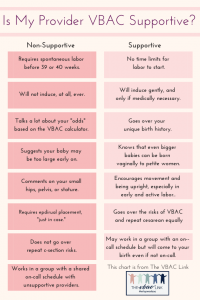When some women are being wheeled into the operating room for their c section they know they want a vaginal birth the next time. This is known as a vaginal birth after cesarean, or VBAC. Others may not know this is an option until they go to their OB for either their follow up or when they find out they are pregnant again. There are many misconceptions surrounding VBAC. I thought it important to put together a list of what to know when preparing for a VBAC.
What is the chance of rupture?
First I think it’s important to correctly define what uterine rupture is. Uterine rupture is a tear through all three layers of the uterus. If you have had a previous c section, the risk of rupture for a TOLAC (trial of labor after cesarean) is 0.4% (or 1 in 240). To put this in perspective, the risk of your baby being cut during your cesarean is 1.5 in 100. So it is just over twice as likely that your baby will be cut during your c section (or repeat c section) than it is for your uterus to rupture. If you have had multiple c sections and are hoping for a vaginal delivery, the estimated rate of rupture for VBAMC is 1.4%. Not a lot of data is available on VBAMC, so that estimate is likely a little higher than the actual numbers.
How can I prepare for my VBAC?
I absolutely LOVE the course offered by The VBAC Link! It is completely online and at your own pace with lifetime access. Click here for more information on the parent course offered by The VBAC Link. They also have a great Facebook group for support.
Other tips:
- Obtain a copy of your operative report from your provider. This should be in your medical records with your OB or midwife, but can also be obtained from the hospital. In the course offered by The VBAC Link there is a worksheet to help you decipher your operative report that I think is immensely helpful. I would strongly recommend reviewing your operative report vis-a-vis this worksheet prior to speaking with your provider.
- Most women are candidates for TOLAC. If you feel your provider is not on board with your plan, seek another opinion (or two). You need to be confident that your provider believes in VBAC as much as (or more than) you do!
- Encourage optimal positioning of your baby before labor begins. Labor is more likely to progress without stalling when your baby is optimally positioned.
- You can encourage optimal positioning through the Miles Circuit (or other Spinning Babies exercises), rebozo sifting, etc. As always, check with your doctor first.
- Hire a doula! While doulas do not have VBAC rates (we aren’t medical providers, after all) we can help you prepare mentally and emotionally, as well as provide you with information to help facilitate discussions with your provider.
Is my provider supportive of VBACs?
 A provider who is truly supportive of VBAC will not have a lot of “rules” or stipulations for your pregnancy or labor. They understand that the risks for a VBAC are lower than the risks for a repeat cesarean and respect that it is your right to choose how you would like to deliver your baby. And if you decide that you would like to have a repeat cesarean that is just as awesome of a decision! This is your body.
A provider who is truly supportive of VBAC will not have a lot of “rules” or stipulations for your pregnancy or labor. They understand that the risks for a VBAC are lower than the risks for a repeat cesarean and respect that it is your right to choose how you would like to deliver your baby. And if you decide that you would like to have a repeat cesarean that is just as awesome of a decision! This is your body.
When speaking with your provider ask open-ended questions to gauge their level of support. Find out what they consider medically necessary reasons for a repeat cesarean. Ask for their VBAC rate and the VBAC rate of their practice as a whole. If they have “good” rates they should be proud to share this information with you! Be on the lookout for scare tactics, including the threat of a “dead baby” if you do not ‘consent’ to a repeat cesarean.
What are the risks of a repeat c section?
The risks of a repeat cesarean are similar to those of a primary cesarean. C sections are surgery, so there is always the risk of infection. It is fairly standard for prophylactic IV antibiotics be given before your doctor makes the incision to help reduce this risk. It is also possible for your surgeon to accidentally nick your bladder or intestines during surgery.
During your c section you will be numb from the nipple line down. This means you will not have control over your bladder. A catheter will be placed in your bladder to collect urine. The area around your urethra will be cleaned prior to catheterization, but there is still a possibility of bacteria entering the bladder. Blood loss and hemorrhaging are also risks to consider when deciding on a repeat cesarean. As mentioned above, there is a 1.5 in 100 chance of your baby being cut during a c section.
Are VBACs always possible?
Unfortunately, there are a few reasons why a VBAC may not be possible. But, thankfully, there aren’t a lot of contraindications. These contraindications include:
- a classical incision during your previous c section
- history of uterine rupture
- surgery that involved an incision on the fundus (or top) of the uterus
- situations that would be a contraindication for a vaginal delivery with no history of a c section
The above reasons are straight out of the course offered by The VBAC Link. I’m telling you – you need to take this course. I cannot stress enough how it will help educate you on vaginal birth after a cesarean.
How long after my c section can I get pregnant?
After six months your scar is as strong as it will be, barring any underlying conditions. In theory it is just as safe to get pregnant at 6 months 1 week post c section as at the three year mark. If you were to get pregnant before 6 months have passed, the risk of rupture is approximately 2.2%. Of course, we always recommend speaking with your medical professional to discuss your unique situation.
I want to extend a HUGE thank you to Julie Francom and Meagan Heaton of The VBAC Link. The course they created has helped me feel beyond confident in my ability to best support our clients who are trying for a VBAC.
Other Blogs You May Find Helpful
C Section Recovery Tips from Your Doulas
BRAIN Acronym and Decision Making
Preparing for an Induction: What to Ask Your Provider
Studies Referenced
The statistics referenced in this article came from the following sources:
This blog is for informational purposes only. It does not diagnose, treat, cure, or prevent any condition. It is not to take the place of speaking with a medical professional.

